Toltec Civilization › Moche Civilization » Ancient origins
Articles and Definitions › Contents
- Toltec Civilization › Ancient History
- Moche Civilization › Antique Origins
Ancient civilizations › Historical and archaeological sites
Toltec Civilization › Ancient History
Definition and Origins
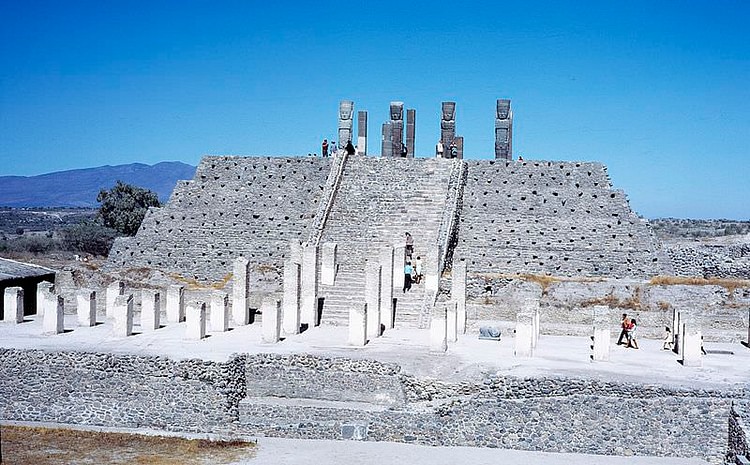
The Toltec civilization flourished in ancient central Mexico between the 10th and mid-12th centuries CE. Continuing the Mesoamerican heritage left to them by the earlier Olmec, Teotihuacan, Maya and others, the Toltecs would build an impressive capital at Tollan and, ultimately, pass on that heritage to later civilizations such as the Aztecs, who regarded the Toltecs as a great and prosperous civilization, even claiming descent from this once great civilization.
Most information on the Toltec comes from Aztec and Post-colonial texts documenting earlier oral traditions. However, these are by no means complete, and information can be coloured by the Aztec's particular reverence for all things Toltec and their delight in merging myth with fact to help establish a lineage with these old masters. Nevertheless, a careful comparison with earlier Mayan texts and the surviving archaeological record does allow for at least the main elements of this civilization to be outlined.
ORIGINS & SPREAD
The Toltecs had roots in the Tolteca-Chichimeca people, who, during the 9th century CE, had migrated from the deserts of the north-west to Culhuacan in the Valley of Mexico. According to the Aztecs, the first Toltec leader was Ce Técpatl Mixcoatl (One Flint Cloud Serpent, ie the Milky Way), and his son Ce Acatl Topiltzin (One Reed Sacrificer, born in either 935 or 947 CE) would go on to gain fame as a great ruler and acquire the name of the great god Quetzalcoatl ('Feathered Serpent') amongst his titles.
THE FIRST SETTLEMENT OF THE TOLTECS WAS AT CULHUACAN, BUT THEY LATER ESTABLISHED A CAPITAL AT TOLLAN (TULA).
The first settlement of the Toltecs was at Culhuacan, but they later established a capital at Tollan (or Tula, meaning 'place of reeds', a general Mesoamerican phrase to apply to all large settlements). The city grew to an area of 14 km² and acquired a population of between 30,000 and 40,000. The heart of the city was laid out in a grid pattern and it is remarkably similar to the Mayan city of Chichen Itza. Intriguingly, the Maya also had a version of a cultural hero known as the 'Feathered Serpent', translated as Kukulcan and contemporary with the Toltec Quetzalcóatl; this and architectural similarities, suggest that there was a close cultural link between the two civilizations.
TOLLAN
The Tollan of Aztec mythology was renowned for its sumptuous palaces and awe-inspiring buildings made from gold, jade, turquoise, and quetzal feathers. The city was also thought to have been flooded with wealth generated by the gifted Toltec craftsmen, highly skilled in metallurgy and pottery - so much so that their potters were said to have 'taught the clay to lie' (Coe, 156) and later Aztec metal-workers and jewellers were even known as tolteca. The Toltecs were also credited with mastering nature and producing huge maize crops and natural coloured cotton of red, yellow, green, and blue. Unsurprisingly, following centuries of looting, no artefacts survive to attest this material wealth except indications that the Toltecs did do a major trade in obsidian (used for blades and arrow heads) which was mined from nearby Pachuca.
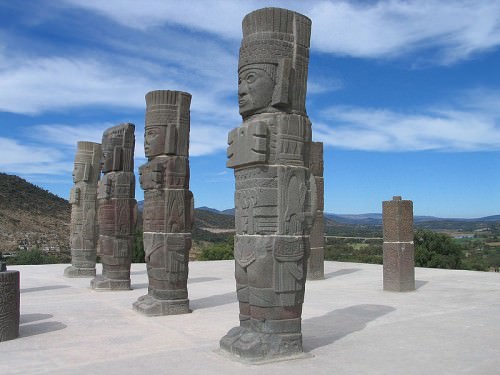
Toltec Warrior Columns
The archaeological site of Tollan, sitting on a limestone promontory, although not quite as splendid as the legend, nevertheless, has an impressive number of surviving monuments. These include two large pyramids, a collonaded walkway, a large palace building, and two ball-courts, all surrounded by a dense area of urban housing. The domestic housing is arranged in groups of up to five flat-roofed residences with each group centred on a courtyard with a single altar and the whole surrounded by a wall.
THE TOLTEC WERE A WARLIKE PEOPLE, NO DOUBT CONQUERING SURROUNDING TRIBES & IMPOSING TRIBUTE WITHOUT ANY CONCERN FOR INTEGRATION.
Surviving architectural sculpture on the pyramids includes large columns, each consisting of four drums, carved as warriors standing atop the five tiers of the 10 m high Pyramid B. The warriors would once have held up a roof structure. The warriors are dressed ready for battle with a drum headdress and butterfly pectoral and each holds an atlatl or spear-thrower at their side. In addition, feathered-snake columns survive from the original doorway. The warrior columns are near-identical and suggest sophisticated workshops capable of mass production.
Friezes run around the pyramids and a free-standing 40 m long L-shaped wall (known as a coatepantli and a Toltec innovation). They show scenes with animals such as the jaguar, wolf, and coyote (symbols associated with a warlike people like the Toltecs), and sacrifice (especially rattlesnakes and skeletons intertwined). There are also images of feathered creatures (perhaps jaguars) and eagles with hearts in their mouths.
Tollan also provides the first examples of chacmools, the reclining stone warriors clutching a vessel on their stomach to receive sacrificial offerings for the gods. These would become a common feature of temples in Mesoamerica. At Tollan they are positioned beside bench-thrones atop the pyramid temple.
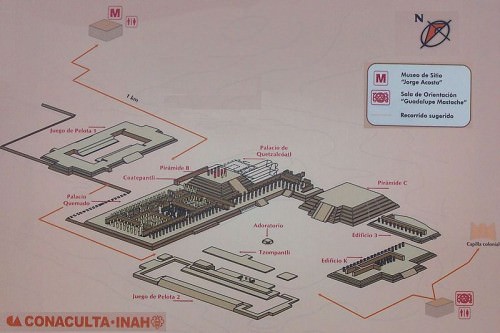
Tollan (Tula)
DECLINE
What ended the Toltec civilization's regional dominance is not known. A warlike people, no doubt conquering surrounding tribes and imposing tribute without any concern for integration into the Toltec political and religious culture, the ' empire ' may well have simply disintegrated when put under the strain of such natural phenomena as a sustained drought. Internal disputes may also have led to the break up of the power structure, and this is hinted at in the legendary stories of battles between the gods Quetzalcoatl and Tezcatlipoca, intertwined with historical figures. What is more certain is that in the mid-12th century CE, Tollán shows signs of violent destruction; many architectural columns and statues were burnt and purposely buried and the site was systematically looted by the Aztecs. Led by the final Toltec leader Huemac, the remnants of the Toltec people re-settled at Chapultepec on the west banks of Lake Texcoco, an event traditionally dated either 1156 or 1168 CE.
LEGACY
The Toltec name carried a certain prestige and they were very highly regarded by the Maya and the Aztecs, in particular, who seem to have copied many aspects of Toltec religious practices and art and looked on the Toltec period as a golden era when such wonders as writing, medicine, and metallurgy were invented. These may well have been invented earlier and by others but more certain is the Toltec influence on architecture and sculpture. Images of recognisable deities at Tollan which would later appear in the Aztec pantheon include Centeotl, Xochiquetzal, Tlahuizcalpantecuhtli and the feathered serpent identified with Quetzalcoatl. Stone carvings of cuauhxicalli vessels and chacmools used in sacrifices and also tzompantli (skull racks) all attest to the influence the Toltecs would have on their more famous successors. In any case, whatever the actual legacy of the people of Tollan, for the Aztecs it was the Toltecs and no other that they sought to claim descent from, and the magnitude of their reverence and respect is evidenced in the Aztec expression Toltecayotl or 'to have a Toltec heart' which meant to be worthy and to excel in all things.
Moche Civilization › Antique Origins
Definition and Origins
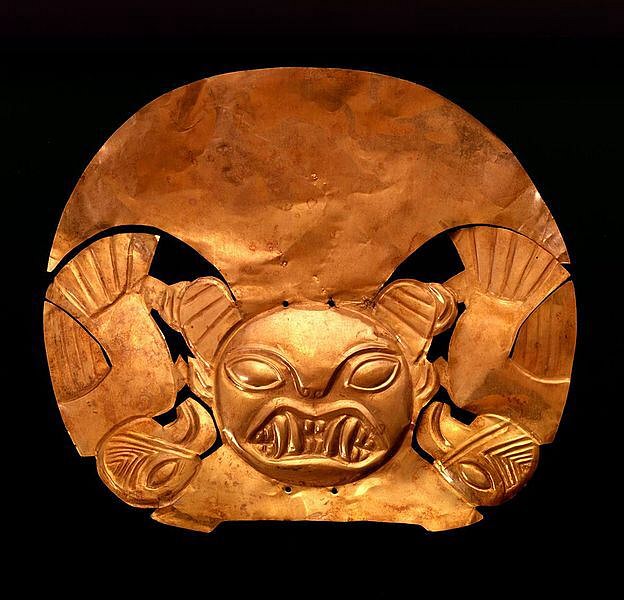
The Moche civilization (also known as the Mochica ) flourished along the northern coast and valleys of ancient Peru, in particular, in the Chicama and Trujillo Valleys, between 1 CE and 800 CE. The Moche state spread to eventually cover an area from the Huarmey Valley in the south to the Piura Valley in the north, and they even extended their influence as far afield as the Chincha Islands. Moche territory was divided linguistically by two separate but related languages: Muchic (spoken north of the Lambayeque Valley) and Quingan. The two areas also display slightly different artistic and architectural trends and so the Moche state may be better described as a loose confederacy rather than a single, unified entity.
The Moche were contemporary with the Nazca civilization (200 BCE - 600 CE) further down the coast but, thanks to their conquest of surrounding territories, they were able to accumulate the wealth and power necessary to establish themselves as one of the most unique and important early-Andean cultures. The Moche also expressed themselves in art with such a high degree of aesthetics that their naturalistic and vibrant murals, ceramics, and metalwork are amongst the most highly regarded in the Americas.
THE MOCHE WERE PERHAPS THE MOST ACCOMPLISHED ARTISTS AND METALWORKERS OF ANY ANDEAN CIVILIZATION.
MOCHE
The capital, known simply as Moche and giving its name to the civilization which founded it, lies at the foot of the Cerro Blanco mountain and once covered an area of 300 hectares. Besides urban housing, plazas, storehouses, and workshop buildings, it also has impressive monuments which include two massive adobe brick pyramid -like mounds. These monumental structures, in their original state, display typical traits of Moche architecture: multiple levels, access ramps, and slanted roofing.
The larger 'pyramid' is the Huaca del Sol, which has four tiers and stands 40 metres high today. Originally it stood over 50 m high, covered an area of 340 x 160 m, and was constructed using over 140 million bricks, each stamped with a maker's mark.A ramp on the north side gives access to the summit, which is a platform in the form of a cross. The smaller structure, known as the Huaca de la Luna, stands 500 metres away and was built using some 50 million adobe bricks. It has three tiers and is decorated with friezes showing Moche mythology and rituals. The entire structure was once enclosed within a high adobe brick wall. Both pyramids were constructed around 450 CE, were originally brightly coloured in red, white, yellow, and black, and were used as an imposing setting to perform rituals and ceremonies. The Spanish conquistadors later diverted the Rio Moche in order to break down the Huaca del Sol and loot the tombs within, suggesting that the pyramid was also used by the Moche for generations as a mausoleum for important persons.
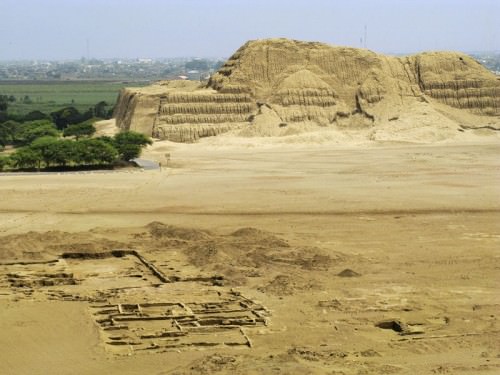
Huaca del Sol, Moche
Buildings excavated between the two pyramid-mounds include many large residences with courtyards enclosed by walls. The fields around the site are laid out in a regular grid pattern of small rectangular plots often with a small adobe viewing platform, which suggests some sort of state supervision and control by the elite (Kuraka) class. Moche agriculture benefitted from an extensive system of canals, reservoirs, and aqueducts, so that the land could support a population of around 25,000.
Other Moche sites include a pilgrimage centre at Pacatnamú, a mountain top site above the Jequetepeque River and actually used from the Early Intermediate Period (c. 200 BCE). There were also administrative centres at Panamarca - where there is another large adobe brick mound, this time with a switch-back ramp leading to the top of the structure - and at Huancaco in the Viru Valley and Pampa de Los Incas in the Santa Valley.
MOCHE RELIGION
Moche religion and art were initially influenced by the earlier Chavin culture (c. 900 - 200 BCE) and in the final stages by the Chimú culture. Knowledge of the Moche pantheon is sketchy, but we do know of Al Paec the creator or sky god (or his son) and Si the moon goddess. Al Paec, typically depicted in Moche art with ferocious fangs, a jaguar headdress, and snake earrings, was considered to dwell in the high mountains. Human sacrifices, especially of war prisoners but also Moche citizens, were offered to appease him, and their blood was offered in ritual goblets. Si was considered the supreme deity, as it was this goddess that controlled the seasons and storms that had such an influence on agriculture and daily life. In addition, the moon was considered even more powerful than the sun because Si could be seen both at night and during the day. It is also interesting that murals and such finds as the intact tomb of the priestess known as La Senora de Cao illustrate that women could play a prominent role in Moche religion and ceremony.
Another deity who frequently appears in Moche art is the half-man, half-jaguar Decapitator god, so-called because he is often represented holding a vicious looking sacrificial knife ( tumi ) in one hand and the severed head of a sacrificial victim in the other. The god may also be depicted as a gigantic spider figure ready to suck the life-blood from his victims. That such scenes mirror real life events is supported by archaeological finds, such as those at the foot of the Huaca de la Luna where skeletons of 40 men under 30 years of age show evidence that they were mutilated and thrown from the top of the pyramid. The bones of these skeletons display cut marks, limbs were ripped out of their sockets, and jaw bones are missing from severed skulls.Interestingly, the bodies lie above soft ground caused by heavy El Nino rains, which suggests the sacrifices may have been offered to the Moche gods in order to alleviate this environmental disaster. Ceremonial goblets have also been discovered which contain traces of human blood, and tombs have revealed costumed and be-jewelled individuals almost exactly like the religious figures depicted in Moche murals.
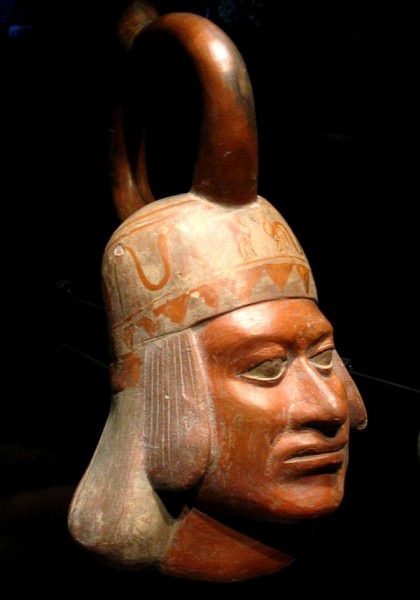
Moche Portrait Vessel
MOCHE ART
Many fine examples of Moche art have been recovered from tombs at Sipán (c. 300 CE), San José de Moro (c. 550 CE), and Huaca Cao Viejo, which are amongst some of the best preserved burial sites from any Andean culture. The Moche were gifted potters and superb metalworkers, and finds include exquisite gold headdresses and chest plates, gold, silver, and turquoise jewellery (especially ear-spools and nose ornaments), textiles, tumi knives, and copper bowls and drinking vessels.Fine pottery vessels were usually made using moulds, but each was individually and distinctively decorated, typically using cream, reds, and browns. Perhaps the most famous vessels are the highly realistic portrait stirrup-spouted pots. These are considered portraits of real people, and several examples could be made depicting the same individual. Indeed one face - easily identified by his cut lip - appears in over 40 such pots.
Pottery shapes and decorations did evolve over time and became more and more elaborate, although conversely, themes became less various in later Moche pottery and art in general. One of the most distinctive styles created by the Moche uses silhouette figures embellished with fine line details very similar to Greek black-figure pottery. Ceramic effigy figures are also common, especially of musicians, priestesses, and captives.
Popular subjects in Moche art - as seen on wall paintings, friezes, pottery decoration, and fine metal objects - include humans, anthropomorphic figures (especially fanged felines), and animals such as snakes, frogs, birds (especially owls), fish, and crabs. Whole scenes are also common, especially religious ceremonies with Bird and Warrior Priests, shamans, coca rituals, armoured warriors, ritual and real warfare with their resulting captives, hunting episodes, and, of course, deities - notably scenes showing night skies across which crescent boats carry figures such as Si. Many of these scenes are rendered to capture narratives and, above all, action; figures are always doing something in Moche art.
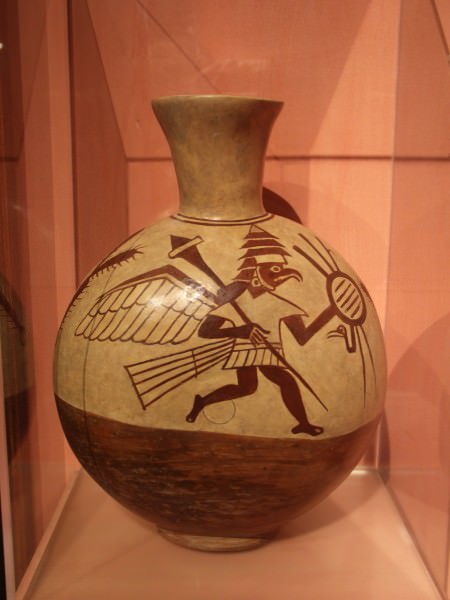
Moche Vessel Depicting Bird Warriors
SIPÁN & PAMPA GRANDE
In c. 550 CE the Moche canal systems and agricultural fields became covered in sand (blown inland from the coast where it had been deposited by erosive flooding from the valleys), and the population left the area, resettling further north in the Lambayeque Valley, notably at the sites of Sipán and Pampa Grande. The move may also have been precipitated by the expansion of the Huari based in the highlands of central Peru. At Sipán some of the best preserved and richest tombs in the Americas have been discovered, including the famous 'Warrior Priest' tomb with its outstanding precious metal objects such as a gold mask, ear-spools, bracelets, body armour, sceptre, ingots, and magnificently crafted silver and gold peanut necklace.
The site of Pampa Grande covered 600 hectares and included the once 55 metre high Huaca Fortaleza ritual platform.Reached by a 290-metre ramp the summit had a columned structure containing a mural of felines. However, after 150 years of occupation the site was also abandoned, once again, probably due to a combination of climatic factors such as an extended period of drought, Huari expansion, and internal strife as indicated by evidence of fire damage to many of the buildings.
LICENSE:
Article based on information obtained from these sources:with permission from the Website Ancient History Encyclopedia
Content is available under License Creative Commons: Attribution-NonCommercial-ShareAlike 3.0 Unported. CC-BY-NC-SA License